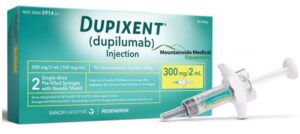Dupixent
Dupixent is a steroid-free, injectable biologic drug works by lowering inflammation (swelling) that can lead to symptoms in eczema or asthma not controlled by other medications. it inhibit the inflammatory response by binding to a protein called interleukin-4 receptor alpha subunit that causes inflammation. Prescribed to adults and children 6 months and older to treat moderate-to-severe eczema. Dupixent is also prescribed for adults and children 6 years and older to treat moderate-to-severe asthma.
Generic name: dupilumab
Drug class: Interleukin inhibitors

Dupixent Precautions and Dosage.
Dupixent should not be given to a child younger than 6 months of age to treat eczema, younger than 6 years of age to treat asthma, under 12 years of age and weighing at least 40 kg to treat eosinophilic esophagitis, or younger than 18 years of age to treat chronic rhinosinusitis with nasal polyposis or prurigo nodularis. Before taking Dupixent tell your doctor if you have eye problems, a parasite infection, if you are going to take Dupixent for eczema and you also have asthma or vice versa, If you are pregnant or if you are scheduled to receive any vaccine.
Adult Dose for Asthma or Prurigo Nodularis.
A) Can be Prescribed 400 mg subcutaneously (two 200 mg injections at different sites), followed by 200 mg subcutaneously every other week
B) Or Can be Prescribed 600 mg subcutaneously (two 300 mg injections at different sites), followed by 300 mg subcutaneously every other week.
Common Adult Dose for Atopic Dermatitis:
Initial dose: 600 mg subcutaneously (two 300 mg injections at different sites)
Maintenance dose: 300 mg subcutaneously every other week
Usual Adult Dose for Sinusitis or Eosinophilic Esophagitis:
300 mg subcutaneously every week for Eosinophilic Esophagitis and every other week for Sinusitis.
Pediatric Dose for Asthma
6 to 11 years (15 to 30 kg) Initial dose and subsequent doses: 100 mg every other week or 300 mg every four weeks
6 to 11 years (30 kg or over) Initial dose and subsequent doses: 200 mg every other week
Pediatric Dose for Atopic Dermatitis:
6 months to 5 years of age (5 to 15 kg)
-Initial dose: 200 mg subcutaneously (one 200 mg injection) every 4 weeks
-Maintenance dose: 200 mg subcutaneously (one 200 mg injection) every 4 weeks
6 months to 5 years of age (15 to 30 kg)
-Initial dose: 300 mg subcutaneously (one 300 mg injection) every 4 weeks
-Maintenance dose: 300 mg subcutaneously (one 300 mg injection) every 4 weeks
6 years to 17 years of age (15 to 30 kg)
-Initial dose: 600 mg subcutaneously (two 300 mg injections at different sites)
-Maintenance dose: 300 mg subcutaneously every 4 weeks
6 years to 17 years of age (30 to 60 kg)
-Initial dose: 400 mg subcutaneously (two 200 mg injections at different sites)
-Maintenance dose: 200 mg subcutaneously every other week
For 60 kg or greater:
-Initial dose: 600 mg subcutaneously (two 300 mg injections at different sites)
-Maintenance dose: 300 mg subcutaneously every other week
Pediatric Dose for Eosinophilic Esophagitis
300 mg subcutaneously every week
Dupixent Side Effects.
Dupixent may cause serious side effects, Before taking Dupixent inform your doctor if you have new or worsening eye pain or discomfort or other eye problems, fast pulse, stomach cramps or blood vessel inflammation–fever, chest pain, trouble breathing, skin rash, numbness or prickly feeling in your arms or legs. Please note Dupixent can cause very serious side effects on eyes or vision, this is very important and not to be ignored to inform doctor if you already have vision problem or eye allergic as mentioned earlier.
Common side effects of Dupixent may include
- Sleep problems .
- Cold symptoms such as stuffy nose, sneezing, sore throat.
- Skin sores or blisters, itching, tingling, burning pain in your thigh or lower back.
- Joint or muscle pain.
- Cold sores or fever blisters on your lips or in your mouth.
- Blood vessel inflammation.
- Eye redness or itching, puffy eyelids.
- Stomach pain, nausea, vomiting, diarrhea.
- Sore throat.
- Tooth pain.
- Bladder pain or urge to urinate frequently.




